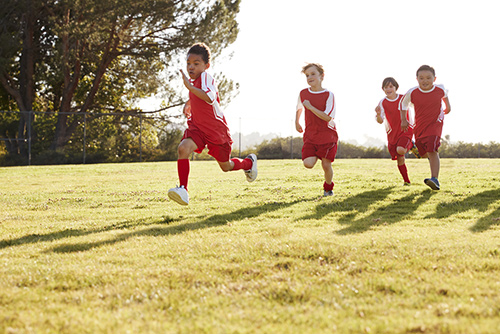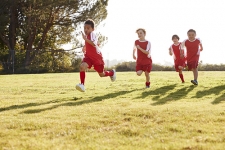
Osgood-Schlatter Disease
Osgood-Schlatter Disease is very common in adolescents, especially during puberty and growth spurts. During these growth spurts, the rapid growth of the quadriceps and tibial tubercle-located on the Tibia (shinbone) and where the patella is connected—causes the patellar tendon to stretch. These rapid changes paired with the sports and activity levels of adolescents can lead to inflammation of growth plate, further pulling the lengthening of the patellar tendon.
With most overuse injuries, the best solution is resting until the pain subsides. Stretching all muscle groups in the legs or using non-steroidal anti-inflammatory medication-such as ibuprofen-helps alleviate the pain. In more severe cases, a cast of immobilizer may be applied to completely rest the knee. Osgood-Schlatters symptoms will disappear after the growth spurts but the prominence of the tubercle will persist.
Resting Osgood-Schlatters are essential as overuse can lead to fractures and even more problems.
Sever’s Disease
Like Osgood-Schlatters, Sever’s Disease is a result of growing pains and overuse. During puberty, the heel bone will grow faster than the muscles and tendons attached, leading to inflammation and causing pain.
The best treatment is to rest the foot until the pain is gone. If the paints persistent, consider investing in heel pads to relieve impact to the heel, stretching the muscles associated with the heel and anti-inflammatory medication. Sever’s Disease will subside one the heel bone is fully grown.
Throwing Injuries in the Elbow
Elbow injuries from overuse are largely seen in baseball. In fact, teenagers are the top recipients of Tommy John surgeries. Overuse in the elbow leads to inflammation in the elbows ligaments, cartilage and growth plates. While youth baseball leagues all have guidelines on the number of pitches, overuse injuries don’t limit themselves to pitchers; any position is vulnerable. If your child is experiencing elbow pain, refrain them from the activity and consider monitoring the number of throws they complete in a game or practice.
Stress Fractures
When muscles are overworked and fatigued, they will transfer the stress from the activities onto their supporting bones, leading to stress fractures. While these stresses placed on the bones are not great enough to cause acute fractures, they still need 6 to 8 weeks of inactivity to heal.
Sufferers of stress fractures will be barred from most physical activities—unless an activity does not affect the damaged bones—until they are fully healed. Stress fractures are usually healed by using immobilizers, braces or a cast to ensure the bones heal properly. If kids resume the activity that caused the stress fracture too quickly, it can lead to larger, more painful and difficult-to-heal stress fractures, and potentially cause chronic problems.
Stress Reaction of Growth Plates
Growth plates are areas of growing tissues which will eventually turn into bone. Repetitive stresses on these areas can damage growth place—making them irregular-and impair growth. The plate may become permanently damaged and stop growing prematurely.
X-rays are used to find damage to the growth plates, but the only treatment is refraining from activity for 2 to 3 months until it heals or is back to normal. It’s a good idea to be more preventative than reactive in this situation.
Prevention
Adequate rest is the best way to prevent overuse injuries. It’s important to note that repetitive motions are a large contributor to these injuries. Single-sport athletes are more vulnerable to these injuries since athletes use the same motions and muscles year round. In fact, studies have shown a higher injury rate in single-sport athletes than multi-sport. Consider enrolling your child in additional sports or have them refrain from their single sport for a portion of the year to avoid overuse injuries.
Soreness is a guaranteed byproduct of physical activity, but it should never be persistent. If your child is experiencing seemingly endless soreness, make them refrain from the activity until it has healed. If the problem persists, schedule an appointment with a doctor immediately.

